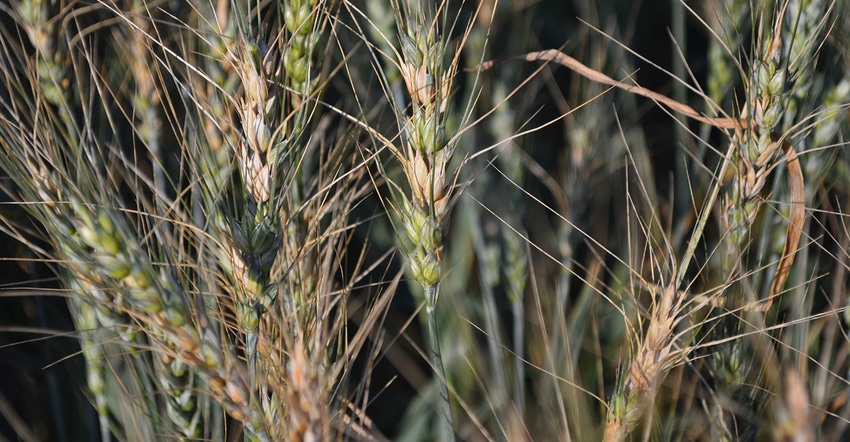May 26, 2017

Fusarium head blight — or scab — is a resilient disease that will come on strong if it is humid and warm when cereal crops start flowering, says Nathan Popiel, Syngenta agronomic service representative in the Northern Plains.
The following six-step plan is suggested by Popiel and Emmanuel Byamukama, South Dakota State University Extension plant pathologist, to protect wheat, barley and other cereal crops:
1. Use the National Fusarium Head Blight Prediction Center’s online tool to monitor the FHB risk this growing season. It uses weather data to predict an outbreak. “You can select a state and zoom in to your location,” Byamukama says. “You can also click on an individual weather station near a growing area and find the FHB prediction for that area. You can assess the scab risk for winter or spring wheat.”
2. When the scab risk is moderate or high, apply a triazole fungicide to protect wheat heads. The fungicide must be applied during flowering or Feekes 10.51. Applications made after flowering are not very effective at slowing the progression of the disease. Apply fungicide with at least 10 gallons of water and use nozzles that create a fine mist. Either ground or application is OK. Follow product labels closely. The goal is to completely cover the heads.
3. After applying fungicide, be on the lookout for scab symptoms. Symptoms include white or bleached heads, brown-purplish stems directly below in the head, pink spore accumulation, and shrunken pink-grayish kernels, Popiel says. It is important to differentiate between bleached heads due to FHB or other causes. If plants are damaged by insects or affected by root or crown rot, the entire plant may be killed and/or the peduncle will also be bleached
4. At harvest, adjust the combine settings. You want to throw as many scab-infected kernels out the back of the machine as possible while keeping as much good wheat as you can. “The fungus sometimes moves to the center stem [rachis] of the head, infecting and damaging the kernels. These kernels may not be ‘scabby,’ but shriveled and shrunken because the fungus killed the rachis and cut off the moisture and nutrient supply to the upper part of the head before those kernels were able to fill,” Byamukama says.
Also, plan your harvest loads carefully. FHB’s most devastating effect on cereals is the level of deoxynivalenol or DON that is often associated with scab-infected grain. The presence of DON, also called vomitoxin, may result in substantial price discounts at the elevator and even rejection of purchase if the levels are high.
While there is no standard for raw grain going into the milling process, the Food and Drug Administration has established the level of 1 part per million as a limit for finished grain products for human consumption. Higher limits exist for feeding to various species of livestock. Reducing the scabby kernels in a load of wheat will lower the DON level as well.
5. Be careful about baling straw from FHB-infected fields and using it as a forage. Research has shown that DON levels in straw can accumulate at much higher levels than found in the grain, Byamukama says. Ten ppm is the highest level of DON suggested for grains and byproducts to be fed to any class of beef cattle. Some studies found DON levels in the straw in excess of 50 ppm, where the DON in the grain was closer to 10 ppm. Testing straw from scab-infected wheat fields for DON is recommended.
6. Finally, don’t save infected seed to plant next year. It can be difficult to tell whether seed is infected or not, Popiel warns. Late-infected kernels may contain the pathogen, but show no symptoms. Therefore, it’s a good strategy to only plant certified seed of a variety that isn’t susceptible to FHB. A variety that is moderately resistant to scab would reduce the risk of a heavy scab development. Also, plan to use a fungicide seed treatment next year to protect the seed. FHB infection can make the seed vulnerable to other pathogens. Avoid planting wheat into corn residue if you can. Fusarium infects cornstalks, too, Popiel says.
You May Also Like




